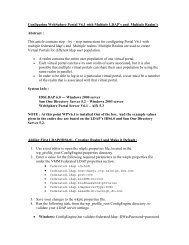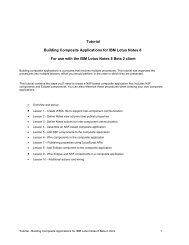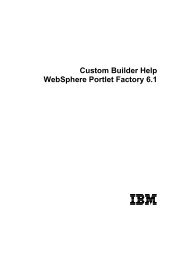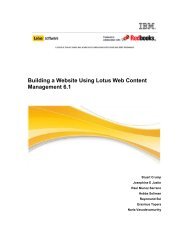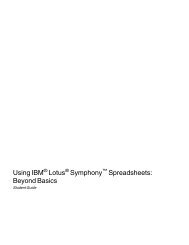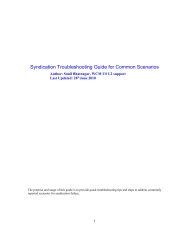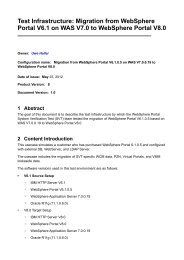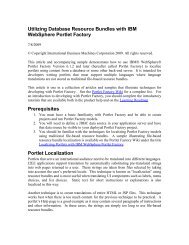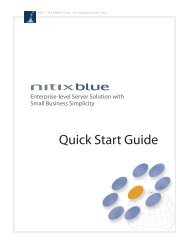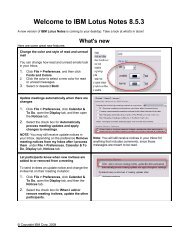IBM WebSphere Portlet Factory Overview - Lotus
IBM WebSphere Portlet Factory Overview - Lotus
IBM WebSphere Portlet Factory Overview - Lotus
You also want an ePaper? Increase the reach of your titles
YUMPU automatically turns print PDFs into web optimized ePapers that Google loves.
Key concepts: builders, models, and profilesWith <strong>WebSphere</strong> <strong>Portlet</strong> <strong>Factory</strong>, developers build portlets by snapping together asequence of components called builders. Each builder has a simple wizard-like userinterface and does the work of automatically generating or modifying part of anapplication. A builder implements an application design pattern.Builders are assembled in models, which are like application production lines. Eachtime a change is made to any of the builders in a model, the application code isregenerated, allowing the developer to iteratively develop a custom portlet application.The builders generate all the application code, including JSPs, Java classes, and XMLdocuments.In addition, developers can create multiple variations of a portlet from one code base,without requiring additional code changes or redeployment. This is done with theprofiling feature of <strong>WebSphere</strong> <strong>Portlet</strong> <strong>Factory</strong>. Different profiles can be created fordifferent user constituencies, based on any characteristics such as region, role, or groupmembership. The profiling technology is also used to support runtime configuration, sothat business users can control application functionality through a simple browserinterface. The net result is that <strong>WebSphere</strong> <strong>Portlet</strong> <strong>Factory</strong> allows companies to rapidlycreate adaptive applications that respond to change on demand – something traditionaltools and technologies simply cannot provide.Using builders to create portlets or servicesDevelopers use <strong>WebSphere</strong> <strong>Portlet</strong> <strong>Factory</strong> models to implement a portlet user interfaceor a data service. After creating a new model, the next step is to start adding buildersto the model, which will create the desired application code (see Figure 2).As described briefly above, builders are software automation components that capturedesign intelligence and automate the creation of code. Similar to customizable robots inan assembly line, builders perform specific software automation tasks, based uponinputs or parameters specified by developers. <strong>WebSphere</strong> <strong>Portlet</strong> <strong>Factory</strong> includes morethan 130 builders that automate a wide range of tasks, such as creating HTML from aschema or integrating with common back-end systems (like Domino, SAP, Siebel,databases, and so on).Builders are selected from the Builder Palette, which lists all the builders by category.The Builder Palette is shown in Figure 2.<strong>WebSphere</strong> <strong>Portlet</strong> <strong>Factory</strong> V6.0.1 Getting Started Guide - 5 -



